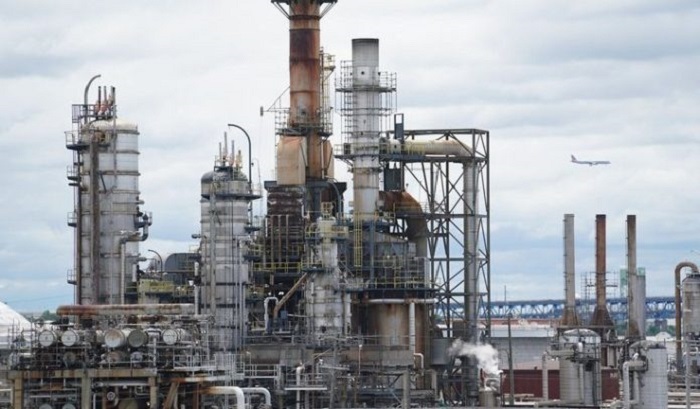At the beginning of 2020, its daily production exceeded two million barrels. Nigeria’s oil production decreased to 1.14 million barrels per day during January 2021, the lowest value recorded in the last years.
Meanwhile Oil prices rose on Friday on continued concerns about supply disruptions for Russian oil and oil products, but were on track for their biggest weekly decline since November after another volatile week
Oil prices soared after Russia invaded Ukraine and hit their highest levels since 2008 but have pulled back a bit this week on hopes that some producing countries may act to increase supply. Fears about escalating bans on Russian oil persist, however, and were back in focus again on Friday.
Brent crude futures climbed $2.86, or 2.6%, to $112.19 a barrel by 1016 GMT. U.S. West Texas Intermediate (WTI) crude futures were up $2.71, or 2.6%, to $108.73 a barrel.
Brent was on track for a weekly fall of 5.4% after hitting $139.13 on Monday. U.S. crude was headed for a weekly drop of 6.2% after touching a high of $130.50 on Monday. Both contracts last touched these price peaks in 2008.
Last week Brent rose over 20%, its biggest weekly rise in percentage terms since May 2020 when Brent traded below $30 a barrel.
Volatility was fuelled this week as the Russia-Ukraine conflict pushed the United States and many Western oil firms to stop buying Russian oil amid talk of potential supply additions from Iran, Venezuela and the United Arab Emirates.
“We have a close eye on the pressure valves that will absorb the supply shock,” said UBS head of economics Norbert Ruecker.
“These include more strategic storage releases, more U.S. shale oil, and more petro-nations’ oil including the element of the high diplomatic cost the West is willing to bear by possibly allowing Iran and even Venezuela back to the market, and ultimately the economic costs by high fuel prices curbing demand and temporarily denting growth.”
Commerzbank analysts said they now forecast Brent to trade above $100 a barrel in the second quarter and around $90 a barrel by the end of the year.
Russia is the world’s top exporter of crude and oil products combined, with exports of around 7 million bpd, or 7% of global supply.
The European Union, heavily reliant on Russian energy, has not joined the United States and Britain in banning Russian oil.
In the near term, supply gaps are unlikely to be filled by extra output from members of the Organization of the Petroleum Exporting Countries and allies, together called OPEC+, given Russia is part of the grouping, Commonwealth Bank analyst Vivek Dhar said.
Also Africa’s largest oil producer, plagued by numerous operational and technical problems in the past few months, had seen production drop below 1.5 million b/d even though it has the capacity to pump over 2 million b/d.
But there have been encouraging signs for the OPEC member as some key export crude grades — such as Agbami, Bonny Light, Forcados and Qua Iboe — have seen steady increases in recent weeks.
Crude and condensate production in January hit a nine-month high of 1,676,646 b/d, up from a more than two decade low of 1,471,210 b/d in December, according to Nigerian Upstream Petroleum Regulatory Commission data.
Officials said similar output levels were seen in the first week of February.
Forcados, which was on force majeure in December due to issues near the export terminal, saw its production recover sharply. Oil fields linked to Forcados pumped 270,439 b/d in January, the highest since October 2020 and after 173,167 b/d in December.
Nigeria’s oil sector finds itself in a fragile state, suffering from major production setbacks and also fighting a wave of divestments from international oil companies.
All its key export crude grades — also including Brass River, Escravos and Yoho — faced many production issues in 2021.
January crude production rose 201,520 b/d month on month to average 1,398,507 b/d, while condensate output rose to 278,138 b/d from 274,213 b/d, NUPRC data showed.
That was still below its January OPEC quota of 1.683 million b/d, as it had been throughout 2021.
Nigeria’s crude oil production caps under the OPEC+ deal for February and March are 1.701 million b/d and 1.718 million b/d, respectively.
Downside risks
Persistent outages on major grades related to theft, pipeline sabotage, unplanned maintenance and technical issues, along with insecurity in the Niger Delta will continue to threaten the growth outlook for Nigeria’s oil output, according to S&P Global Platts Analytics.
Oil supply will grow to 1.7 million b/d by mid-2022, from 1.3 million b/d in December but downside risks on ongoing issues remain, it said in its recent forecast.
“Declines are expected in 2023 and onwards due to a lack of project FIDs, stalled on the now-passed petroleum bill. We expect new projects to ramp up in the late 2020s/early 2030s,” it said.


Comment here